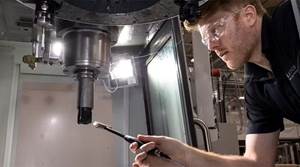Remote CNC Access And Operation
An all-hardware interface grants real-time access to CNC functions via the Internet without taxing the machine's brainpower.
Share





Remote Machining melds two seemingly antithetical concepts‚ÄĒcontrol and freedom‚ÄĒso that shops can do some reconnaissance work or tweak parameters on their own terms. The manufacturer‚Äôs self-titled, all-hardware interface grants real-time access to all CNC functions via the Internet so that shop personnel can manipulate the process, regardless of their proximity to the actual machine.
Operators can edit programs, check cut progression or troubleshoot from any PC‚ÄĒbe it in a hotel lobby or a home office‚ÄĒas long as there is Internet connectivity. The interface assuages logistical concerns for the user without taxing the machine‚Äôs brainpower. It consists of an adapter and a centralized controller, which are completely independent of software, operating system or controller type. The virtual ‚Äúspy‚ÄĚ does not encumber the CNC. Rather, it gains access by splicing into the I/O from the controller side. In essence, the machine is not even cognizant of this ‚Äúspy.‚ÄĚ
‚ÄúThe product is piggybacking, not taxing the control with extra functions,‚ÄĚ explains Tim Zott, president of Remote Machining (West Bloomfield, Michigan).
The product is compatible with machining centers, grinding machines, lasers, lathes, plasma cutters, waterjets, EDMs and other CNC-controlled machines. Thus far, it has been predominantly adopted in EDMs because they are generally run unattended more frequently than other machines. Makino offers the interface as a third-party option for its wire and ram EDMs.
Basic shopfloor requirements are at least one PC with Internet connectivity in the building and a LAN connection (within cabling distance) to the machine. Shop personnel can log on to their company’s own internal infrastructure to tinker with certain parameters and functions, but in such a way that does not interfere with the integrity of the process. All modifications must be in accordance with OSHA regulations, which stipulate that axes cannot move without an interlock system. Thus, Mr. Zott says, users can’t execute changes that cause direct movement of the cutting axes outside of what is specified in the loaded program. They can, however, check in periodically to see if alarms have been triggered or to gauge overall machining efficiencies and possibly make adjustments.
‚ÄúWith EDMs, for instance, the shop could modify cutting parameters remotely,‚ÄĚ explains Brian Pfluger, Makino senior applications engineer. ‚ÄúAlthough it can‚Äôt start the machine, the shop could edit the speeds and feeds and power elements, as well as halt production.‚ÄĚ
From an application support standpoint, the product can better equip engineers to bridge the gap between perceptions of what is going on with the reality of what is actually occurring at the machine. Mr. Pfluger says the system is beneficial when providing technical assistance and when training new users, especially during the first year of machine ownership.
‚ÄúThis often helps us make machining adjustments so that the customer‚Äôs part is running more efficiently,‚ÄĚ he comments.
This first year of ownership, Mr. Zott says, typically represents the highest incurrence of costs related to technical services and support as well as machine downtime. This product can ease some of those expenses.
‚ÄúNow, a 15-minute conversation might suffice instead of the lengthy and often frequent exchanges between the application engineers and new machine users,‚ÄĚ he says. ‚ÄúThe manufacturer‚Äôs engineer need only log-in through a secure access port to view the CNC screen and adjust parameters‚ÄĒall of this can be done live with the machine operator logged on as well.‚ÄĚ
Related Content
Cutting Part Programming Times Through AI
CAM Assist cuts repetition from part programming — early users say it cuts tribal knowledge and could be a useful tool for training new programmers.
Read MoreHow to Mitigate Chatter to Boost Machining Rates
There are usually better solutions to chatter than just reducing the feed rate. Through vibration analysis, the chatter problem can be solved, enabling much higher metal removal rates, better quality and longer tool life.
Read MoreTips for Designing CNC Programs That Help Operators
The way a G-code program is formatted directly affects the productivity of the CNC people who use them. Design CNC programs that make CNC setup people and operators’ jobs easier.
Read More6 Machine Shop Essentials to Stay Competitive
If you want to streamline production and be competitive in the industry, you will need far more than a standard three-axis CNC mill or two-axis CNC lathe and a few measuring tools.
Read MoreRead Next
Machine Shop MBA
Making Chips and 91 ”∆ĶÕÝ’ĺőŘ are teaming up for a new podcast series called Machine Shop MBA—designed to help manufacturers measure their success against the industry’s best. Through the lens of the Top Shops benchmarking program, the series explores the KPIs that set high-performing shops apart, from machine utilization and first-pass yield to employee engagement and revenue per employee.
Read MoreLast Chance! 2025 Top Shops Benchmarking Survey Still Open Through April 30
Don’t miss out! 91 ”∆ĶÕÝ’ĺőŘ's Top Shops Benchmarking Survey is still open — but not for long. This is your last chance to a receive free, customized benchmarking report that includes actionable feedback across several shopfloor and business metrics.
Read MoreAMRs Are Moving Into Manufacturing: 4 Considerations for Implementation
AMRs can provide a flexible, easy-to-use automation platform so long as manufacturers choose a suitable task and prepare their facilities.
Read More





















